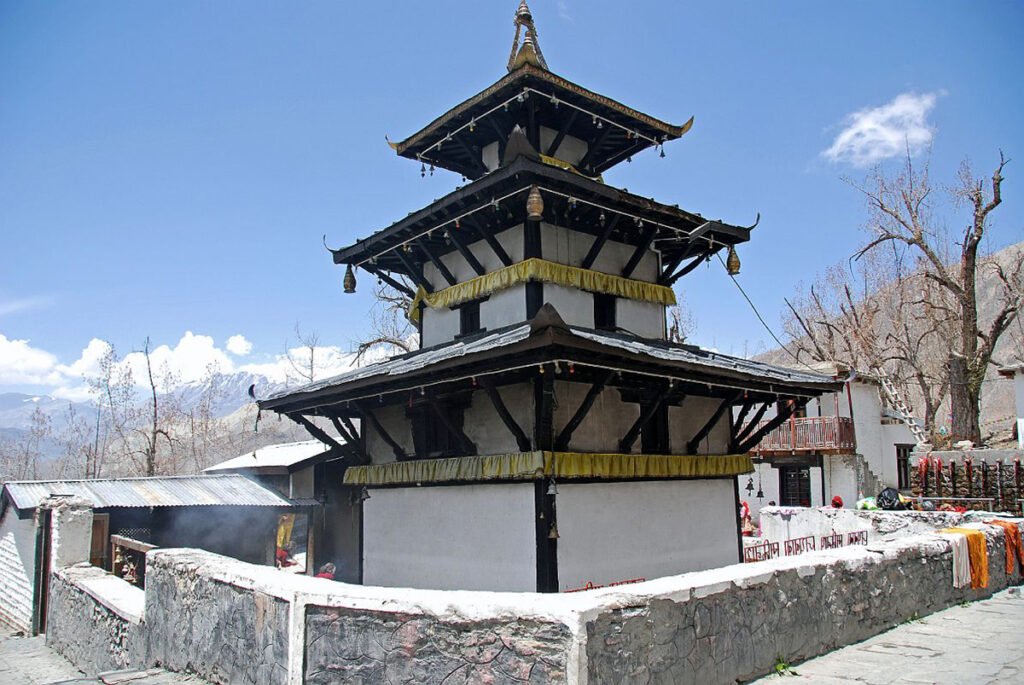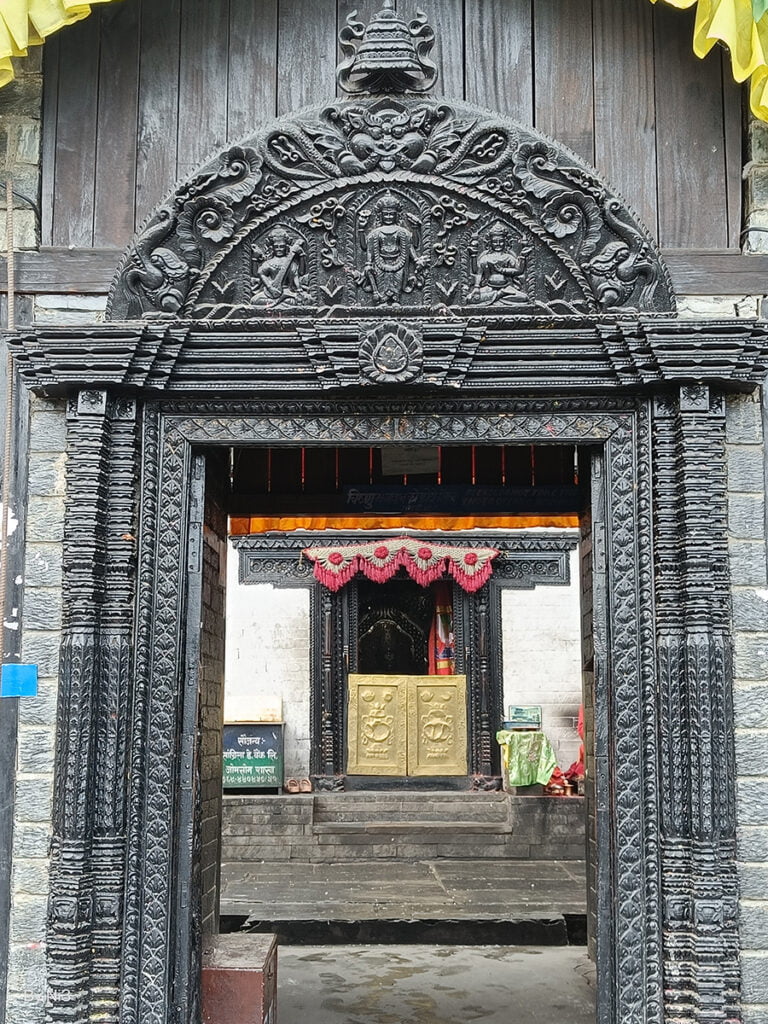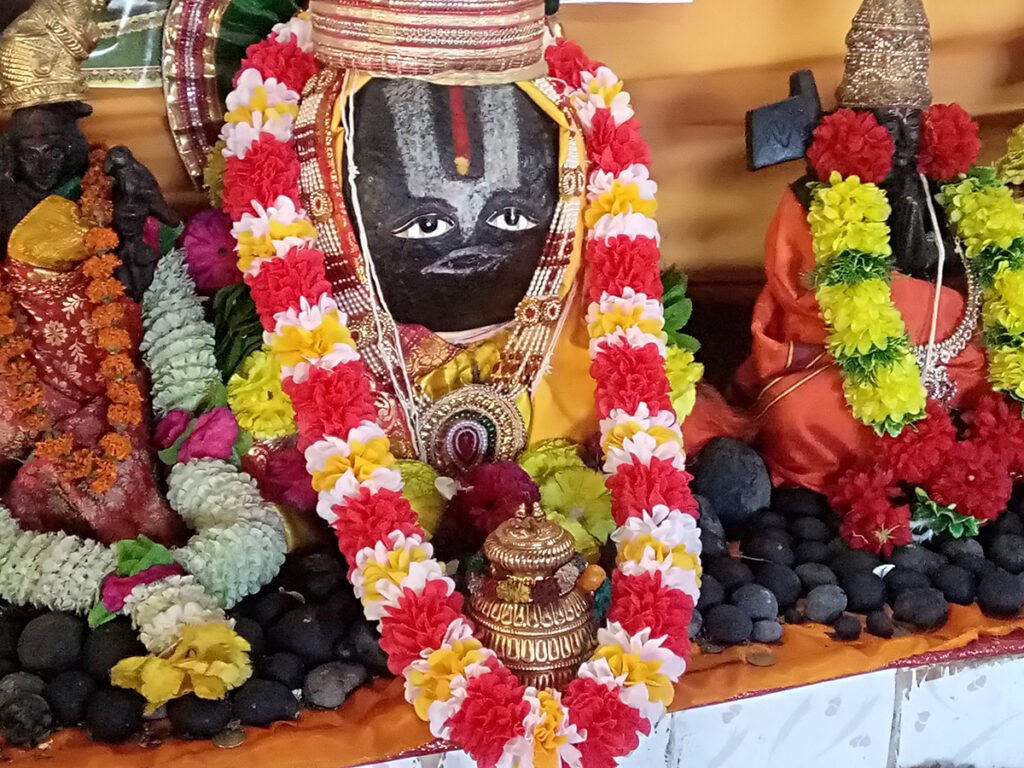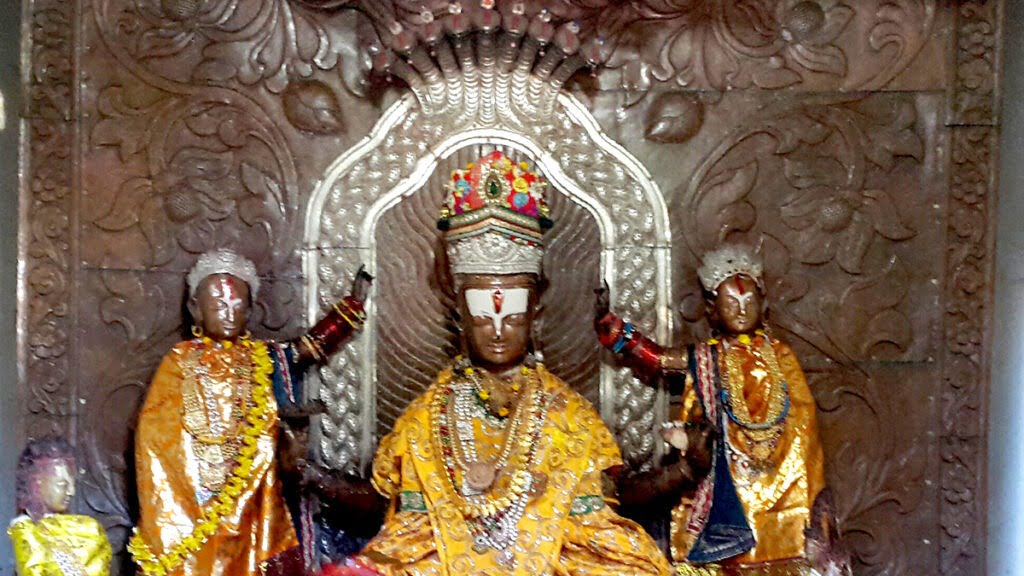Gandaki Shakti Peeth Muktinath Temple
Gandaki Shakti Peeth or Mukthinath Temple is a revered Hindu pilgrimage site located in the Gandaki River basin, near Pokhara in Nepal. It is one of the Shakti Peethas, a group of sacred temples dedicated to the goddess Shakti.

Contents
- 1 Significance:
- 2 Belief:
- 3 History of Muktinath Temple:
- 4 The legend of the Gandaki Shakti Peeth
- 5 Places to visit near Gandaki Shakti Peeth:
- 6 FAQ:
- 6.0.1 Q: What is the Gandaki Shakti Peeth?
- 6.0.2 Q: What is the significance of the Gandaki Shakti Peeth?
- 6.0.3 Q: What is the history of the Gandaki Shakti Peeth?
- 6.0.4 Q: What are the opening hours of the Gandaki Shakti Peeth?
- 6.0.5 Q: What are the dress code requirements for the Gandaki Shakti Peeth?
- 6.0.6 Q: What are the things to see and do at the Gandaki Shakti Peeth?
- 6.0.7 Where is Muktinath Temple located?
- 6.0.8 Who is the presiding deity of Muktinath Temple?
- 6.0.9 What is the significance of Muktinath Temple?
- 7 How to Reach Gandaki Shakti Peeth Muktinath Temple:
- 8 Google Maps:
Significance:
According to the mythology Daksha yagna and Sati self-immolation, it is the holy place where Sati Devi’s “temple” fell down. Sati Devi is worshipped as Gandakichandi (One who can make you overcome obstacles) with her consort Lord Shiva as Chakrapani (one who holds chakra – discus).
Belief:
- People who have a bath in the river Gandaki are said to wash away their sins and attain salvation as the sacred saligram stones which are used to build lord Vishnu’s temple are present in river Gandaki.
- If there is any unfulfilled desire or wish of an individual they will be fulfilled here once worshipped to goddess Gandaki with devotion.
Read More>> Secret Goddess: Guhyeshwari Temple
History of Muktinath Temple:
The Muktinath Temple is a sacred Hindu and Buddhist temple located in the Mustang district of Nepal. It is situated at an altitude of 3,710 meters (12,172 feet), making it one of the highest religious shrines in the world.
The temple is dedicated to Muktinath, a form of the Hindu god Vishnu. It is also revered by Buddhists as Chumig Gyatsa, a place of pilgrimage associated with Guru Rinpoche, the founder of Tibetan Buddhism.
The history of the Muktinath Temple is uncertain, but it is believed to be over a thousand years old. The temple is mentioned in the Vishnu Purana, a Hindu scripture dating back to the 4th or 5th century AD.
The temple has been damaged by earthquakes and floods over the centuries, but it has always been rebuilt. The current temple was built in the 17th century by the king of Mustang, Rana Bahadur Shah.
The Muktinath Temple is a popular pilgrimage destination for both Hindus and Buddhists. Devotees come to the temple to pray for salvation and to seek blessings from Muktinath.
The temple complex consists of a main shrine, a pond, and 108 waterspouts. Devotees take a sacred bath in the pond and then drink water from the 108 waterspouts. They then pray at the main shrine and offer flowers, incense, and butter lamps.
The Muktinath Temple is a significant religious site for Hindus and Buddhists alike. It is a place where people from different faiths come together to worship and seek spiritual enlightenment.
Read More>> Biraja Temple Shakti Peeth Jaipur

The legend of the Gandaki Shakti Peeth
The legend of the Gandaki Shakti Peeth tells the story of how the body part of Sati fell here. Sati was the wife of Shiva, the god of destruction. Her father, Daksha Prajapati, did not approve of her marriage to Shiva, and he organized a yagna, or fire sacrifice, to which he invited all the gods and goddesses, but not Shiva.
Sati was insulted by her father’s actions, and she decided to go to the yagna to confront him. When she arrived, Daksha insulted Shiva again, and Sati was so angry that she jumped into the fire.
Shiva was overcome with grief when he learned of Sati’s death. He went on a rampage, destroying everything in his path. The gods were afraid of Shiva’s wrath, and they asked Vishnu, the god of preservation, to help them.
Vishnu used his Sudarshan Chakra, a spinning disc of energy, to dismember Sati’s body into 51 pieces. The pieces of Sati’s body fell all over India, and each place where a piece fell became a Shakti Peetha.
Read More>> Jalandhar Shakti Peeth Devi Talab Mandir

Places to visit near Gandaki Shakti Peeth:
Kanchenjunga Base Camp: If you’re interested in trekking and mountaineering, you can embark on a trek to the Kanchenjunga Base Camp. The Kanchenjunga Massif is one of the world’s highest mountain ranges, and the trek offers breathtaking views and a chance to explore the pristine Himalayan landscape.
Ilam: Ilam is a beautiful hill station in Nepal known for its lush tea gardens. It’s a great place to relax and enjoy the serene atmosphere. You can visit the Ilam Tea Garden, Mai Pokhari Lake, and other scenic spots.
Sandakphu: Located on the border of Nepal and the Indian state of West Bengal, Sandakphu is another trekking destination. It offers panoramic views of the Himalayas, including Mount Everest, Makalu, and Kanchenjunga. It’s a trekker’s paradise.
Mai Beni: Mai Beni is a sacred river where the Mai Beni Mela takes place during the Nepalese New Year. It’s a place of religious significance and a popular spot for pilgrims.
Halesi Mahadev Temple: Halesi Mahadev Temple is another important religious site located in Khotang, not far from the Gandaki Shakti Peeth. It’s known for its unique cave shrine dedicated to Lord Shiva.
Pashupatinath Temple: While not exactly close to the Gandaki Shakti Peeth, Pashupatinath Temple in Kathmandu is one of the most significant Hindu temples in Nepal. It’s a UNESCO World Heritage Site and a must-visit for its cultural and architectural significance.
Biratnagar: If you’re looking for a larger city with more amenities and services, Biratnagar is one of the major cities in eastern Nepal. It’s known for its industrial and commercial activities and has a vibrant culture.
Pathibhara Devi Temple: In addition to the Gandaki Shakti Peeth, you can also explore the Pathibhara Devi Temple in the same region. It’s a sacred site dedicated to Goddess Pathibhara.
Varaha Kshetra: This temple complex dedicated to Lord Vishnu is situated near Ilam and is of great religious importance.

FAQ:
Q: What is the Gandaki Shakti Peeth?
A: The Gandaki Shakti Peeth is one of the 51 Shakti Peethas in Hinduism. It is located in Nepal, at the source of the Gandaki River. The temple is dedicated to the goddess Uma Devi, who is also known as Parvati.
Q: What is the significance of the Gandaki Shakti Peeth?
A: The Gandaki Shakti Peeth is a sacred place for Hindus. Devotees believe that visiting the temple and worshiping Uma Devi can help them to attain moksha, or liberation.
Q: What is the history of the Gandaki Shakti Peeth?
A: The history of the Gandaki Shakti Peeth is not well-documented. However, it is believed to have been established in ancient times. The temple is mentioned in the Puranas, which are a collection of ancient Hindu texts.
Q: What are the opening hours of the Gandaki Shakti Peeth?
A: The Gandaki Shakti Peeth is open from 5:00 AM to 9:00 PM.
Q: What are the dress code requirements for the Gandaki Shakti Peeth?
A: Visitors are required to wear modest clothing when visiting the Gandaki Shakti Peeth. Men should wear long pants and a shirt that covers the shoulders. Women should wear a long skirt or pants and a top that covers the shoulders and chest.
Q: What are the things to see and do at the Gandaki Shakti Peeth?
A: The main attraction of the Gandaki Shakti Peeth is the temple itself. The temple is a beautiful example of Hindu architecture.
Where is Muktinath Temple located?
Muktinath Temple is situated in the Muktinath Valley in the Mustang district of Nepal, in the Annapurna Conservation Area.
Who is the presiding deity of Muktinath Temple?
Muktinath Temple is dedicated to Lord Vishnu in the form of Muktinath, which means “Lord of Liberation.” It is also a significant site for Buddhists who worship the deity Avalokiteshvara.
What is the significance of Muktinath Temple?
Muktinath is considered a sacred place of salvation and liberation. It is believed that a visit to this temple helps devotees attain moksha (liberation) from the cycle of birth and death.

How to Reach Gandaki Shakti Peeth Muktinath Temple:
By Air (Domestic Flights):
The fastest way to reach Muktinath is to take a domestic flight from Tribhuvan International Airport in Kathmandu to Jomsom Airport. Jomsom is the closest airport to Muktinath.
After arriving at Jomsom, you can hire a jeep or take a local bus to reach Muktinath. The drive from Jomsom to Muktinath takes approximately 1-2 hours.
By Road:
If you prefer a scenic road trip, you can drive or take a bus from Kathmandu or Pokhara to Muktinath. The journey is long and may take several days, but it offers beautiful views of the Himalayas.
The road to Muktinath is rough and can be challenging, so it’s essential to have a reliable vehicle and an experienced driver. You can also hire a jeep or van in Kathmandu or Pokhara for a more comfortable journey.
Here’s a general route if you choose to travel by road:
From Kathmandu: The route from Kathmandu usually involves traveling through Pokhara, Beni, and then driving to Jomsom. From Jomsom, you can continue the journey to Muktinath.
From Pokhara: If you start from Pokhara, you’ll head directly to Beni and then continue towards Jomsom and Muktinath.
You can also take a bus from Kathmandu to Pokhara and then continue the journey by road from there.
